PIONEER DDJ-SB3
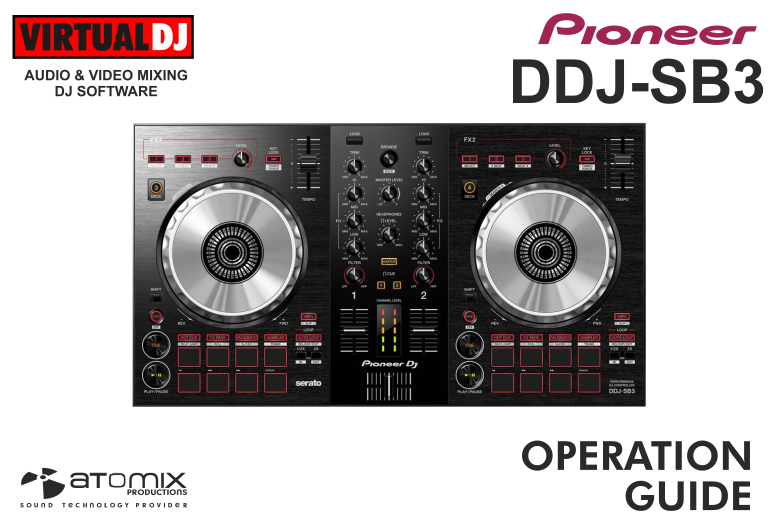
SETUP
Firmware & Drivers
Firmware: Update the firmware of the unit to the latest version from https://www.pioneerdj.com/en/support/software/ddj-sb3/#firmware-update
Drivers You don't have to install any driver software. The DDJ-SB3 is a USB Class Compliant device and your Operating System (Windows/mac OS) will install and use the standard audio driver when the device is connected to your Mac/PC with a USB cable
VirtualDJ Setup
Once VirtualDJ is launched, a Connect Window will appear. Login with your virtualdj.com account credentials.
A Pro Infinity, a Subscriber or a PLUS License is required to fully use the Pioneer DDJ-SB3. Without any of the above Licenses, the controller will operate for 10 minutes each time you restart VirtualDJ.
https://www.virtualdj.com/buy/index.html
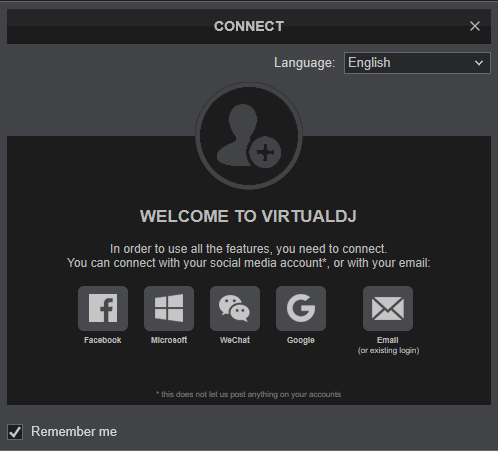
Click on the DDJ-SB3 button if speakers are connected to the Master Output of the DDJ-SB3. You can still change that from Settings->AUDIO tab.
Click to OK.

The unit is now ready to operate with VirtualDJ.
MIDI Operation
The unit should be visible in the MAPPING tab of Config and the “factory default” available/selected from the Mappings drop-down list. The factory default Mapping offers the functions described in this Manual, however those can be adjusted to your needs via VDJ Script actions.

Find more details at
https://www.virtualdj.com/wiki/VDJ8script.html
AUDIO Setup
The unit has a pre-defined Audio setup and a special button in the AUDIO tab of Config to provide that.

Please read the manual of DDJ-SB3 for further functionality https://www.pioneerdj.com/en/support/documents/ddj-sb3/
For further software settings please refer to the User Guides of VirtualDJ.
https://www.virtualdj.com/manuals/virtualdj8/index.html
LAYOUT

S SHIFT. Hold this button down to access secondary functions of the Pioneer DDJ-SB3, as described in this manual
The functionality of each button, knob and slider per section (as shown in the image above) will be explained in detail in the following chapters
A Mixer & Browser
B Deck Controls
C Performance Pads
D Front & Rear panels
MIXER & BROWSER CONTROLS

- CROSSFADER: Blends audio (& video if LINK is enabled from the VIDEO panel of VirtualDJ) between the left and the right assigned channels.
- VU METERS: The 2 (Left/Right) series of leds indicate the pre-fader output level of the Left/Right assigned Deck
- VOLUME: Channel Volume Faders. Faders alter the sound of the left and right assigned decks. If SHIFT is pressed the Volume Faders will additionally play and sync the track if the fader moves from 0% position and will stop (at the Cue position) the track if the volume reaches 0% position again (Fader Start/Stop).
- CUE 1/2: Press these buttons to send left or/and right channel's pre-fader signal to the Cue Channel for monitoring. When engaged, the button will be lit.
- CUE MASTER: Press this button to send the Master Output signal to the Cue Channel for monitoring. When enabled, the button will be lit.
- * FILTER: Applies a resonance filter (High Pass/Low Pass) to the left/right track. Middle position is Off position.
- * EQ: Adjusts the high (treble) / middle (mid) / low (bass) frequencies of the track.
- * TRIM: Adjusts the Gain applied to the left/right assigned Deck. When at middle position, the deck will be output at the defined zero db level (by default 0db).
- LOAD: Use these buttons to load the selected track from the Browser to the left/right assigned VirtualDJ deck.
Hold SHIFT down and then use the left-side LOAD button to sort Browser tracks by BPM field. Hold SHIFT down and then use the right-side LOAD button to sort Browser tracks by Artist field - BROWSE:
Use this knob to scroll through files or folders.
Push the knob to cycle through the available/opened Browser windows (Folders, Songs, Sideview)
If focus is on the Folders list, hold SHIFT down and then push the knob to open/close subfolders.
If focus is on the Songs List, hold SHIFT down and then push the knob to add the selected song to the Automix List.
If focus is on the Sideview, hold SHIFT down and then push the knob to cycle through the available views of Sideview (Automix, Sidelist, Karaoke, Sampler and Shortcuts) - MASTER LEVEL: Adjust the level of the Master Sound Output (connection at the rear panel). The knob is not controlling the Master Output level of the software (hardware operation), but when moved from the hardware, its position will be reflected in the VirtualDJ GUI.
- HEADPHONES LEVEL: Controls the level of the Headphones Output (connection at the front panel). The knob is not controlling the Headphones Output level of the software (Hardware operation), but when moved from the hardware, its position will be reflected in the VirtualDJ GUI.
* Note The device is offering Full Stems controls. See details at EQ Modes
DECK CONTROLS
S SHIFT. Hold this button down to access secondary functions of the Pioneer DDJ-SB3, as described in this manual
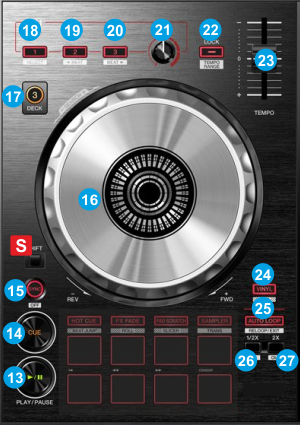
- PLAY: Plays-Pauses the track. If SHIFT is pressed it plays the track in Stutter.
- CUE: If the track is playing, pauses and goes to the last cue point. If the track is paused is paused, sets the current position as cue point, and previews the cue as long as the button is pressed. If SHIFT is pressed, it jumps to the beginning of the track.
- SYNC: Syncs the tempo and phase of this deck with the deck that is set as Master (indicated with the M button in the 4 Decks default skin). The Master Deck is automatically by default (auto mode)
Hold SHIFT down and then use this button to manually set a deck as Master.
Once a Deck is manually set as Master, the auto-selection of the Master Deck will not be available. To return to the auto-selection, you will need to press the same button again on the Deck that is currently set as Master. - JOG: Touch sensitive platter for scratching (vinyl mode) or bending (CD Mode) depending on the VINYL mode (24).
Hold SHIFT and use the JOG in Seek (Search) mode. - DECK.
Use the left-side button to assign Deck 1 or Deck 3 as Left selected Deck. When the LED is lit Deck 3 will be controlled by the left side of the DDJ-SB3.
Use the right-side button to assign Deck 2 or Deck 4 as Right selected Deck. When the LED is lit, Deck 4 will be controlled by the right side of the DDJ-SB3.
Note: Due to a firmware limitation, these buttons will not work and swap Decks, unless the DDJ-SB3 sound card is used in Audio Setup. - FX ON 1: Press this button to activate the selected effect of slot 1. Hold SHIFT and then press this button to select the next available Effect from the list for Effect slot 1
- FX ON 2: Press this button to activate the selected effect of slot 2. Hold SHIFT and then press this button to select the next available Effect from the list for Effect slot 2
- FX ON 3: Press this button to activate the selected effect of slot 3. Hold SHIFT and then press this button to select the next available Effect from the list for Effect slot 3
- FX LEVEL KNOB: Use this knob to adjust the 1st parameter of the selected effects from all effect slots. Hold SHIFT down and then use this knob to control the 2nd parameter of the selected effects from all effect slots.
- KEYLOCK: Press this button to enable/disable the Master Tempo (Key Lock) of the deck.
Hold SHIFT and press this button to cycle through the available Pitch ranges for the PITCH/Tempo Slider. - PITCH: Adjusts the tempo of the track.
- VINYL: Sets the Jog of the deck to Bend (CD) or Scratch (Vinyl) Mode.
Hold SHIFT down and then use this button to enable/disable Slip mode. When Slip mode is enabled, several functions (scratching, HotCues, Loops etc.) will act temporary and the track will resume to the position it would have been if this function was never triggered. - AUTOLOOP: Use this button to enable/disable an Auto-Loop of the selected size of Beats.
Hold SHIFT and then use this button to enable the last triggered loop (and jump to its position). - LOOP 1/2: Use this button to half the size of the Loop.
When not in Loop, hold SHIFT down and then use this button to set current track's position as the start point of a manual loop.
When in Loop, hold SHIFT down and then use this button to enable/disable Loop In Adjust mode and then use the jogwheel to fine-adjust the start point of the loop. - LOOP 2X: Use this button to double the size of the Loop.
When not in Loop, hold SHIFT down and then use this button to set current track's position as the end point of a manual loop.
When in Loop, hold SHIFT down and then use this button to enable/disable Loop Out Adjust mode and then use the jogwheel to fine-adjust the end point of the loop.
PERFORMANCE PADS

- PAD MODE. Press any of the 4 available Pad mode buttons to set the Pads to Hotcues, FX Fade, Pad Scratch and Sampler mode.
Hold SHIFT and then press any of the 4 available Pad mode buttons to set the Pads to Beatjump, Loop Roll, Slicer and Trans mode.
Note Due to firmware limitation, Split Pages are not offered from the device's Pad mode buttons. - PADS. The 8 Pads offer different functionality depending on the selected mode.
The Parameters of each mode can be adjusted from the VirtualDJ GUI (Pads section)
Read further details about Pads in the VirtualDJ 8 manual
HOTCUES
Each one of the 8 pad assigns a Hot Cue Point (1 to 8) or jumps the track to that Hot Cue Point (if assigned).
When a Hot Cue Button is unlit, you can assign a Hot Cue Point by pressing it at the desired point in your track. Once it is assigned, the Hot Cue Button will light on.
Hold SHIFT and then press a pad to delete its assigned Hot Cue Point.
.
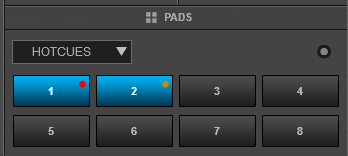
FX FADE
The FX Fade is a mode controlled from the unit's firmware. Each Pad performs a function provided from the DDJ-SB3, and cannot be assigned to any VirtualDJ action. The functionality of the Pads in this mode, only operate when triggered from the DDJ-SB3 and the Pads on the GUI will not perform any action.
.
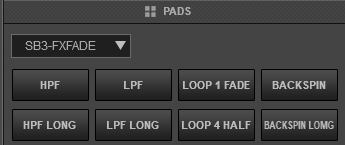
In this mode:
- PAD 1 : Press Pad 1 from DDJ-SB3. Its led will start blinking and a High-Pass Filter will be applied, starting from the Off position, gradually increasing and stop at the maximum Cut. Press again to turn off the High-Pass Filter and automatically bring Filter to its Off position.
- PAD 2 : Press Pad 2 from DDJ-SB3. Its led will start blinking and a Low-Pass Filter will be applied, starting from the Off position, gradually decreasing and stop at the minimum Cut. Press again to turn off the Low-Pass Filter and automatically bring Filter to its Off position.
- PAD 3 : Press Pad 3 from DDJ-SB3. Its led will start blinking, an Auto-Loop of 1 beat will be enabled at the current position and the Deck's Volume will gradually decrease and will reach the minimum position (Fade). Press the same Pad again, to turn off the Loop and bring Volume back to the position it was before the Pad was enabled.
- PAD 4 : Press Pad 4 from DDJ-SB3. Its led will start blinking, and the track will perform a Back-spin*. When the back-spin is completed, the track will automatically resume playing from the current position.
- PAD 5 : Press Pad 5 from DDJ-SB3. Its led will start blinking and a High-Pass Filter will be applied, starting from the Off position, gradually increasing and stop at the maximum Cut. Press again to turn off the High-Pass Filter and automatically bring Filter to its Off position. This Pad works similar to Pad 1, but the time required to reach from the Off position to the maximum Cut positions is longer
- PAD 6 : Press Pad 6 from DDJ-SB3. Its led will start blinking and a Low-Pass Filter will be applied, starting from the Off position, gradually decreasing and stop at the minimum Cut. Press again to turn off the Low-Pass Filter and automatically bring Filter to its Off position. This Pad works similar to Pad 2, but the time required to reach from the Off position to the minimum Cut positions is longer.
- PAD 7 : Press Pad 7 from DDJ-SB3. Its led will start blinking and an Auto-Loop of 4 beats will be enabled at the current After the 4 beat loop is played once, the loop size will be automatically set to 2 beats. After the 2 beats loop is played 2 times, the loop size will be automatically set to 1 beat. After the 1 beat loop is played 4 times, the loop-size will be automatically set to 1/2 beat. After the 1/2 beat loop is played 8 times, the loop-size will be automatically set to 1/4 beats and stay enabled, until the Pad is pressed again.
- PAD 8 : Press Pad 8 from DDJ-SB3. Its led will start blinking, and the track will perform a Back-spin*. When the back-spin is completed, the track will automatically resume playing from the current position. This Pad offers the same functionality as Pad 4, but the Backspin in this case will be longer.
* Back-spin duration can be adjusted from the DDJ-SB3 Utilities. See further details in the DDJ-SB3 Manual https://www.pioneerdj.com/en/support/documents/ddj-sb3/
PAD SCRATCH
Press the PAD SCRATCH mode button to set the PADs to Pad Scratch mode (button will be lit solid) and automatically load the Pad Scratch Pads page in VirtualDJ GUI
The PAD SCRATCH is a mode controlled from the unit's firmware. Each Pad performs a function provided from the DDJ-SB3, and cannot be assigned to any VirtualDJ action. The functionality of the Pads in this mode, only operate when triggered from the DDJ-SB3 and the Pads on the GUI will not perform any action.

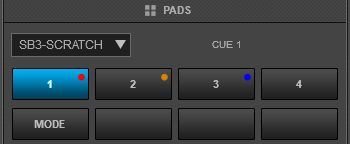
In this mode, each one of the 8 Pads performs a different Scratch routine as long as the Pad is pressed, starting from the selected Hotcue and its steps will be synchronized to the tempo of the track. When the Pad is released, the track will resume playback.
Hold SHIFT down and then press Pads 1 to 4, to select Hotcue 1 to 4 as the selected Hotcue for the scratch routine. If the Hotcue is not assigned, and a Pad scratch Pad (1 to 8) is pressed, the selected Hotcue will be set at the current track's position.
Hold SHIFT and then press Pad 5 to select a release mode for the Scratch routines. If disabled (its led will be off), after releasing a Pad Scratch routine pad (1 to 8), the track will resume playback from the current position. If enabled (its led will be lit), after releasing a Pad Scratch routine pad (1 to 8), the scratch routine will continue until it reaches the Hotcue and after that, will continue playback.
Pads 6 to 8 when SHIFT is pressed, have no functionality in this mode.
Tip: For best Scratch performance, make sure the TouchWheelSpinThreshold setting (in VirtualDJ->Settings->Options tab) is set at value 2.0 or higher (default value is 0.8)
SAMPLER
Each one of the 8 pads triggers a sample from the selected Sampler Bank of VirtualDJ. If a bank has less than 9 samples, both sides of the DDJ-SB3 will control the same samples. If a bank has more than 8 samples, the left side of the DDJ-SB3 will control samples 1 to 8 and the right side samples 9 to 16.
Press the pads to trigger a sample. Depending on the selected trigger Pad mode, use SHIFT and the same pads to stop the sample.
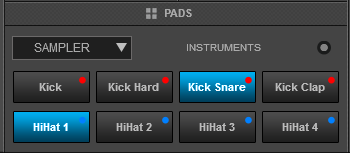
Use the Parameter arrow-buttons from the GUI of VirtualDJ (Pads section) to select the Sampler Bank (previous/next).
Beatjump mode
In this mode, each one of the Pads will jump the track backwards/forward by the amount of beats depending on the selected page/bank (from 1/8 beats to 32 bars)
Use the Parameter arrow buttons from the VirtualDJ GUI (Pads section) to select the previous/next page with the desired Beats sizes

LOOP ROLL
Press one of the 8 pads to trigger a momentary Loop Roll. Once the Pad is released, the track will resume playing from the position it would have been if the Loop Roll was never triggered. The exit point will be visible on the waveform of the VirtualDJ GUI with an additional “running” play marker.
Hold SHIFT to get a ½, ¾, 1 and 2 beats Loop Roll sizes for the 4 low pads.
Use the Page menu to apply the Loop Rolls to Video.

SLICER
The 8 pads represent eight sequential beats—"Slices"—in the Beat Grid. The currently playing Slice is represented by the currently green lit pad. The light will move through the pads as it progresses through each eight-Slice phrase. Press a pad to repeat that Slice (hold it down if you want to keep looping it).
Once the Pad is released the track will continue to play from the position it would have been if the pad was never pressed.
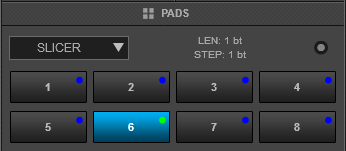
Hold SHIFT and then use the Pads to repeat the memorized Slices (the Slices played/repeated last time)
Use the Parameter arrow-buttons from the GUI of VirtualDJ (Pads section) to adjust the length of the Loop applied to the slice. or adjust the step of the Slices
TRANS
The TRANS is a Pads mode controlled from the unit's firmware. Each Pad performs a function provided from the DDJ-SB3, and cannot be assigned to any VirtualDJ action. The functionality of the Pads in this mode, only operate when triggered from the DDJ-SB3 and the Pads on the GUI will not perform any action.
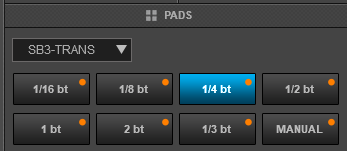
- Pads 1 to 7 perform a Cut Effect of a different size in Beats (from 1/16 to 2 beats) by automatically toggling the Deck's volume
between the current and the minimum position.
- Pad 8 offers the ability to perform a Manual Cut Effect, by automatically set Deck's volume to minimum position while pressed and set back to the previous-memorized volume when released.
FRONT & REAR PANELS

- HEADPHONES SOCKET Connect your Headphones for monitoring using the 1/8" socket. The level of this output is controlled from the HEADPHONE LEVEL knob at the top panel

- USB. Connect the DDJ-SB3 with your computer via a USB port using the provided USB cable
- MASTER OUTPUT (RCA). Un-balanced Main Output. Connect your amplifier or amplified speakers using common RCA cables. The Level of this Output is controlled from the top panel
- MIC INPUT. Connect your Microphone using a proper 1/4" cable/adapter The Volume of this Input is controlled from the knob at the side of this socket.
Note that the Microphone Input is not part of the USB Audio Interface and its signal will be directly routed to the Master Output of the DDJ-SB3, thus it cannot be included to the Audio setup of VirtualDJ, nor can be recorded within VirtualDJ.
